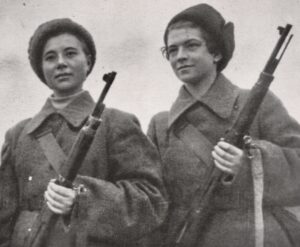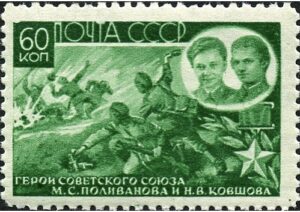Natalya Kovshova and Mariya Polivanova: Female Snipers Loyal to the End

Female sniper partners, Natalya and Mariya, were loyal to the end.
My dearest Mama! Please don’t be angry that I didn’t write to you about being wounded. But I didn’t want to worry you for no reason, since nothing serious happened…
–letter from Sniper Natasha Kovshova to her mother, July 7, 1942
On a hot, sultry mid-August afternoon, Private Natasha (Natalya) Koshova, a pretty 22-year-old sniper with a heart-shaped face and chestnut-brown hair that curled around her brow from the humidity, was covering a unit of Red Army riflemen pushing back German counter-attacks. It was 1942 and Natasha had been on the front for ten months, partnered with her good friend, 20-year-old Private Masha (Mariya) Polivanova, reserved with a small chin and dark, hooded eyes that gave her a thoughtful air.
They’d met in Moscow two years earlier, while working for the same research institute. After Germany invaded the Soviet Union, in 1941, Natasha convinced Masha to join a self-defence unit created when German bombs started falling on Russian land. Both girls received sniper training within this unit and, in January 1942, they joined the 528th Rifle Regiment on the North-Western front. Right away, they found themselves on the offensive, near Demyansk, forcing the Germans to retreat from Moscow.
It didn’t take long for Natasha and Masha to get “a reputation as skilled snipers, Natasha being seen as brave to the point of recklessness,” writes fellow sniper, Lyuba Vinogradova in her memoir, Avenging Angels: Soviet Women Snipers on the Eastern Front. “She was a particularly accurate markswoman, able to hit an enemy soldier in the head at 300 metres.”
Masha had a particular knack for disabling enemy machine-gun setups and, during the Battle of Rzhev, northeast of Smolensk, she demonstrated extraordinary physical strength and courage when she carried wounded soldiers from her unit to safety, under heavy German fire.
Both Natasha and Masha were wounded in battles in the spring, 1942, and spent time in a field hospital recuperating.

Depicted is the greatest sacrifice these female snipers made, in the last scene of their lives.
For six months, their regiment took part in battles, with the goal of encircling the Germans and forcing them to surrender. At one point, six German divisions were surrounded by Red Army troops, but this hold broke in May. The fighting continued and in July, the Germans captured Smolensk, an integral mainstay on the route to the Russian capital, further weakening Moscow’s defense. Still, a German offensive would have exposed its own flanks. For this reason, the Wehrmacht was ordered to divide and head north and south to attack the Red Army at Leningrad and Kiev.
The girls’ regiment also marched south, to the village of Sutoki in the Novgorod Oblast (province). Sutoki was a heavily forested area, near the Volkhov River, a major waterway that had been part of a trade route since medieval times.
On August 13, Natasha’s mother received a letter, with money enclosed, from her daughter, which is reprinted in Boets-snaiper (Sniper-fighter) Natasha Kovshova: “We have made a major move, about 115 kilometres, and are now attacking in a different place with another army. It is very swampy here and we are in mud up to our knees…As it’s possible for you to buy something, and something so delicious too, it’s better if you have the money rather than me. I won’t need it until after the war, and then I’d like to buy a really nice dress!”
The next day, Natasha and Masha were wounded by enemy fire. Then, they ran out of ammunition and their entire regiment was cornered by German soldiers. Within minutes, everyone was killed except the girls and Major General Pyotr Novikov, huddled in a trench.
“Novikov was shot in the stomach and the Germans took him for dead,” writes Vinigradova in Avenging Angels. “That night he crawled back to the Soviet lines and told them that when the Germans approached the girls had blown up themselves and several of the enemy with a grenade.”
Together, Natasha and Masha accumulated a tally of more than 300 confirmed kills. Together, they died. Together, they were posthumously awarded Hero of the Soviet Union for their bravery, heroism and sacrifices.